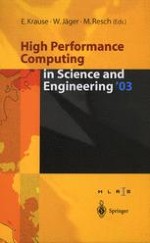2003 | OriginalPaper | Buchkapitel
Water on Mars
verfasst von : Tetsuya Tokano
Erschienen in: High Performance Computing in Science and Engineering ’03
Verlag: Springer Berlin Heidelberg
Enthalten in: Professional Book Archive
Aktivieren Sie unsere intelligente Suche, um passende Fachinhalte oder Patente zu finden.
Wählen Sie Textabschnitte aus um mit Künstlicher Intelligenz passenden Patente zu finden. powered by
Markieren Sie Textabschnitte, um KI-gestützt weitere passende Inhalte zu finden. powered by
A milestone in the understanding of the Martian hydrological evolution and water cycle is being marked by the Gamma-Ray Spectrometer (GRS) onboard Mars Odyssey ([1], [2], [4]). These gamma rays are supposed to be produced during inelastic collision and/or capture of secondary neutrons which were produced in the soil by cosmic rays. The signals are indicative of the presence of a large amount (at least 35 wt %) of hydrogen below a dry layer in this region. The Neutron Spectrometer [2] and the High Energy Neutron Detector (HEND) [4] measured leakage fluxes of fast, epithermal and thermal neutrons produced in the same way. As hydrogen has a strong ability to slow down the neutrons, depression of neutron fluxes, especially of faster ones, can be interpreted by a large abundance of hydrogen and hence H2O. Both instruments detected a large region around the south pole southward of 60°S (with an area of 107 km2) with strongly reduced epithermal fluxes indicative of large water abundance. In general the upper 15–20 cm of the soil at low and mid latitudes was inferred to be water-poor dust layer underlain by a slightly water-richer regolith [2]. The global map of fast neutrons (indicative of the upper layer) showed a somewhat different picture, particularly those measured by HEND. The area with a large deficit of fluxes was larger at northern high latitudes (107 km2) than at southern latitudes (4 x 106 km2). In all maps the global distribution is not symmetric about the equator and some distinct longitudinal variation is also discernible.
